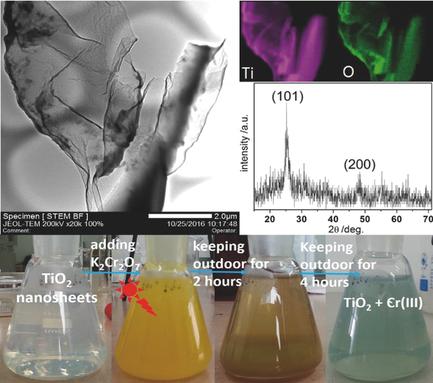Our official English website, www.x-mol.net, welcomes your
feedback! (Note: you will need to create a separate account there.)
Low Temperature Synthesis of Large‐Size Anatase TiO2 Nanosheets with Enhanced Photocatalytic Activities
Small ( IF 13.0 ) Pub Date : 2017-11-10 , DOI: 10.1002/smll.201701964 Xiao Tang 1 , Wanyi Chu 2 , Jueshi Qian 2 , Jingcheng Lin 1 , Guozhong Cao 3
Small ( IF 13.0 ) Pub Date : 2017-11-10 , DOI: 10.1002/smll.201701964 Xiao Tang 1 , Wanyi Chu 2 , Jueshi Qian 2 , Jingcheng Lin 1 , Guozhong Cao 3
Affiliation

|
TiO2 nanosheets have continuously been intriguing due to their high surface activities as photocatalyst but still challenging to synthesis large‐scale 2D nanostructures. A special microstructure evolution of TiO2, ripening in aqueous solution at low temperature (≈4 °C), is found for the first time, i.e., from the initial aperiodic atom‐networks gradually into low crystallized continuous spongy structure with small crystal facets and ultimately forming large‐size anatase nanosheets with exposed (101) and (200) facets. Based on this finding, the synthesized anatase TiO2 nanosheets possess monodispersed large‐scale 2D nanostructure so as to exhibit appreciable quantum size effects and remarkable enhanced optical absorption capacity. Using photocatalytic reduction of Cr (VI) to Cr (III) as the probe reaction to evaluate photocatalytic activities of the TiO2 nanosheets, the reductivity of Cr (VI) achieves 99.8% in 15 min under irradiation of 200–800 nm light. At the same time, an in situ Cr (III)‐doping occurs spontaneously and triggers pronounced visible light driven photocatalysis, reducing 99% of Cr (VI) in 100 min under irradiation of 400–800 nm light.
中文翻译:

低温合成具有增强光催化活性的大尺寸锐钛矿型TiO2纳米片
TiO 2纳米片由于其作为光催化剂的高表面活性而一直吸引着人们,但仍然对合成大规模2D纳米结构具有挑战性。首次发现了TiO 2的特殊微观结构演化,该过程在水溶液中于低温(≈4°C)下成熟,即从最初的非周期性原子网络逐渐发展为具有小晶面和低结晶度的低结晶连续海绵状结构。最终形成具有(101)和(200)小面暴露的大尺寸锐钛矿纳米片。基于该发现,合成了锐钛矿型TiO 2纳米片具有单分散的大规模二维纳米结构,从而表现出明显的量子尺寸效应和显着增强的光吸收能力。使用Cr(VI)到Cr(III)的光催化还原作为探针反应来评估TiO 2纳米片的光催化活性,在200-800 nm的光照射下,Cr(VI)的还原率在15分钟内达到99.8%。同时,原位Cr(III)掺杂自发发生,并引发明显的可见光驱动的光催化作用,在400–800 nm的光照射下,在100分钟内还原了99%的Cr(VI)。
更新日期:2017-11-10
中文翻译:

低温合成具有增强光催化活性的大尺寸锐钛矿型TiO2纳米片
TiO 2纳米片由于其作为光催化剂的高表面活性而一直吸引着人们,但仍然对合成大规模2D纳米结构具有挑战性。首次发现了TiO 2的特殊微观结构演化,该过程在水溶液中于低温(≈4°C)下成熟,即从最初的非周期性原子网络逐渐发展为具有小晶面和低结晶度的低结晶连续海绵状结构。最终形成具有(101)和(200)小面暴露的大尺寸锐钛矿纳米片。基于该发现,合成了锐钛矿型TiO 2纳米片具有单分散的大规模二维纳米结构,从而表现出明显的量子尺寸效应和显着增强的光吸收能力。使用Cr(VI)到Cr(III)的光催化还原作为探针反应来评估TiO 2纳米片的光催化活性,在200-800 nm的光照射下,Cr(VI)的还原率在15分钟内达到99.8%。同时,原位Cr(III)掺杂自发发生,并引发明显的可见光驱动的光催化作用,在400–800 nm的光照射下,在100分钟内还原了99%的Cr(VI)。











































 京公网安备 11010802027423号
京公网安备 11010802027423号